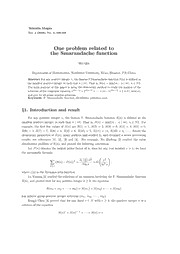Table Of ContentScientia Magna
Vol. 4 (2008), No. 3, 106-108
One problem related to
the Smarandache function
Wei Qin
Department of Mathematics, Northwest University, Xi’an, Shaanxi, P.R.China
Abstract For any positive integer n, the famous F.Smarandache function S(n) is defined as
the smallest positive integer m such that n | m!. That is, S(n)=min{m: n | m!, n∈N}.
The main purpose of this paper is using the elementary method to study the number of the
solutionsofthecongruentequation1S(n−1)+2S(n−1)+···+(n−1)S(n−1)+1≡0(modn),
and give its all prime number solutions.
Keywords F. Smarandache function, divisibility, primitive root.
§1. Introduction and result
For any positive integer n, the famous F. Smarandache function S(n) is defined as the
smallest positive integer m such that n | m!. That is, S(n) = min{m : n | m!, n ∈ N}. For
example, the first few values of S(n) are S(1) = 1, S(2) = 2, S(3) = 3, S(4) = 4, S(5) = 5,
S(6) = 3, S(7) = 7, S(8) = 4, S(9) = 6, S(10) = 5, S(11) = 11, S(12) = 4, ···. About the
elementary properties of S(n), many authors had studied it, and obtained a series interesting
results, see references [1], [2], [3] and [4]. For example, Xu Zhefeng [2] studied the value
distribution problem of S(n), and proved the following conclusion:
Let P(n) denotes the largest prime factor of n, then for any real number x > 1, we have
the asymptotic formula
(cid:161) (cid:162) (cid:195) (cid:33)
(cid:88)(S(n)−P(n))2 = 2ζ 23 x32 +O x23 ,
3lnx ln2x
n≤x
where ζ(s) is the Riemann zeta-function.
Lu Yaming [3] studied the solutions of an equation involving the F. Smarandache function
S(n), and proved that for any positive integer k ≥2, the equation
S(m +m +···+m )=S(m )+S(m )+···+S(m )
1 2 k 1 2 k
has infinite group positive integer solutions (m , m , ··· , m ).
1 2 k
Rongji Chen [4] proved that for any fixed r ∈ N with r ≥ 3, the positive integer n is a
solution of the equation
S(n)r+S(n)r−1+···+S(n)=n
Vol. 4 OneproblemrelatedtotheSmarandachefunction 107
if and only if
n=p(pr−1+pr−2+···+1),
where p is an odd prime such that
pr−1+pr−2+···+1 | (p−1)!.
On the other hand, in reference [5], C. Dumitrescu and V. Seleacu asked us to study the
solvability of the congruent equation
1S(n−1)+2S(n−1)+···+(n−1)S(n−1)+1≡0 mod n. (1)
About this problem, it seems that none had studied it yet, at least we have not seen any
related papers before. In this paper, we use the elementary method and the properties of the
primitive roots to study the solvability of the congruent equation (1), and obtain its all prime
solutions. That is, we shall prove the following conclusion:
Theorem. Let n be a prime, then n satisfy the congruent equation
1S(n−1)+2S(n−1)+···+(n−1)S(n−1)+1≡0 mod n
if and only if n=2, 3 and 5.
It is clear that our Theorem obtained all prime solutions of the congruent equation (1).
About the general solutions of the congruent equation (1) is still an unsolved problem.
2. Proof of the theorem
In this section, we shall complete the proof of our Theorem directly. We only discuss the
prime solutions of (1).
(1) For n=2, since 2 | 1S(1)+1=2, so n=2 is a prime solution of (1).
(2) For n=3, since 3 | 1S(2)+2S(2)+1=6, so n=3 is a prime solution of (1).
(3) For n = 5, since 5 | 1S(4) +2S(4) +3S(4) +4S(4) +1 = 355, so n = 5 is also a prime
solution of (1).
(4)Forprimen=p≥7,itisclearthatphasatleastaprimitiveroot. Letg beaprimitive
(cid:161) (cid:162)
root of p, that is to say, gi−1, p =1 for all 1≤i≤p−2, the congruences
gp−1 ≡1 mod p and gm(p−1) ≡1 mod p (2)
hold for any positive integer m.
Then from the properties of the primitive root mod p we know that g0, g1, ···, gp−2 is a
reduced residue class. So we have the congruent equation
1S(n−1)+2S(n−1)+···+(n−1)S(n−1) (3)
≡g0·S(p−1)+g1·S(p−1)+···+g(p−2)·S(p−1)
g(p−1)·S(p−1)−1
≡ mod p.
gS(p−1)−1
108 WeiQin No. 3
(cid:161) (cid:162)
Itisclearthatforanyprimep≥7,wehaveS(p−1)≤p−2,so gS(p−1)−1, p =1. Therefore,
from (2) and (3) we have
g(p−1)·S(p−1)−1
1S(n−1)+2S(n−1)+···+(n−1)S(n−1) ≡ ≡0 mod p.
gS(p−1)−1
So from this congruence we may immediately get
1S(n−1)+2S(n−1)+···+(n−1)S(n−1)+1≡1 mod p.
Thus, if prime p≥7, then it is not a solution of (1). This completes the proof of Theorem.
References
[1] F. Smarandache, Only Problems, Not Solutions, Chicago, Xiquan Publishing House,
1993.
[2] Xu Zhefeng, The value distribution property of the Smarandache function, Acta Math-
ematica Sinica, Chinese Series, 49 (2006), No.5, 1009-1012.
[3] Lu Yaming, On the solutions of an equation involving the Smarandache function, Sci-
entia Magna, 2(2006), No.1, 76-79.
[4]RongjiChen,OnthefunctionalequationS(n)r+S(n)r−1+···+S(n)=n,Smaraandache
Notions Journal, 11(2000), No.1-2-3, 128-130.
[5] C. Dumitrescu and V. Seleacu , The Smarandache Function, Erhus University Press,
USA, 1996.
[6]ZhangWenpeng, Theelementarynumbertheory(inChinese), ShaanxiNormalUniver-
sity Press, Xi’an, 2007.
[7] Tom M.Apostol, Introduction to Analytic Number Theory, New York, Springer-Verlag,
1976.
[8] Kenichiro Kashihara, Comments and topics on Smarandache notions and problems,
Erhus University Press, USA, 1996.

